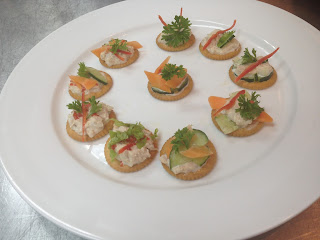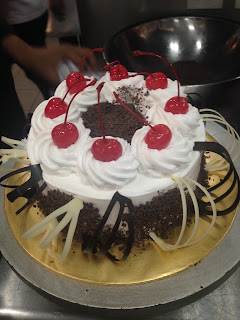INTERNATIONAL CUISINE - WEEK 8 ( MEXICO CUISINE)
INTRODUCTION
Introduction
Mexico Cuisine
-
In
week 8, we have to cover chapter 8 that is Mexico cuisine. The cuisine that we
learn is beef fajitas that from Mexico. Other than that, we was cooking beef
burger and was sell in the college that is to many student and lecturer buy
that.
History
of Mexico Cuisine
-
Mexican cuisine began about 9,000 years ago, when agricultural communities
such as the Maya formed, domesticating maize, creating the
standard process of corn nixtamalization, and establishing their food
ways. Successive waves of other Mesoamerican groups brought with them
their own cooking methods. These includedthe Olmec, Teotihuacanos, Toltec, Huastec, Zapotec, Mixtec, Otomi, Purépecha, Totonac, Mazatec,
and Mazahua.
The Mexico establishment of the Aztec
Empire created a multi-ethnic society where many different food ways
became infused. The staples are native foods, such
as corn, beans, squash, amaranth, chia, avocados, tomatoes, tomatillos, cacao, vanilla, agave, turkey, spirulina, sweet
potato, cactus, and chilli pepper.
After the Spanish conquest of the Aztec Empire in the
16th century, Europeans introduced a number of other foods, the most important
of which were meats from domesticated animals (beef, pork, chicken, goat, and
sheep), dairy products (especially cheese and milk), and rice. While the
Spanish initially tried to impose their own diet on the country, this was not
possible.
African and Asian influences were also introduced into the
indigenous cuisine during this era as a result of African slavery in New
Spain and the Manila-Acapulco Galleons.
Over the centuries, this resulted in regional cuisines based on
local conditions, such as those in Oaxaca, Veracruz and
the Yucatán Peninsula. Mexican cuisine is an important aspect of the
culture, social structure and popular traditions of Mexico. The most important
example of this connection is the use of mole for special occasions
and holidays, particularly in the South and Centre regions of the country. For
this reason and others, traditional Mexican cuisine was inscribed in 2010 on
the Representative List of the Intangible Cultural Heritage of
Humanity by UNESCO.
-
One of the most interesting
facets of the American culinary revolution of the past 50 years is our growing
fascination with culinary history. It seems the more we learn about the ethnic
melting pot that makes up the American table, the more curious we become about
regional cuisines and the origin of specific dishes. Texas is the proud home of
an authentic regional cuisine, and the provenance of Tex-Mex foods is currently
a very hot topic with everyone from academic researchers to cookbook authors to
magazine and newspaper food writers. In exploring the history of fajitas,
several credible stories emerge, and all of them have roots in the Rio Grande
Valley of Texas. It only makes sense that several people from the same ethnic
group with roots in the same geographic area would come up with similar cooking
techniques and names for the raw materials at hand.
The first serious study of the history of fajitas was done in 1984
by Homero Recio as part of his graduate work in animal science at Texas
A&M. Recio was intrigued by a spike in the retail price of skirt steak, and
that sparked his research into the dish that took the once humble skirt steak
from throwaway cut to menu star. Recio found anecdotal evidence describing the
cut of meat, the cooking style (directly on a campfire or on a grill), and the
Spanish nickname going back as far as the 1930s in the ranch lands of South and
West Texas. During cattle roundups, beef were butchered regularly to feed the
hands. Throwaway items such as the hide, the head, the entrails, and meat
trimmings such as skirt were given to the Mexican vaqueros (cowboys) as part of
their pay. Hearty border dishes like barbacoa de cabeza (head barbecue), menudo
(tripe stew), and fajitas/arracheras (grilled skirt steak) have their roots in
this practice. Fifth-generation McAllen rancher and cookbook author Melissa
Guerra heard very similar stories in researching her first cookbook, The
Texas Provincial Kitchen, and her upcoming work, Dishes of the Wild
Horse Desert. Considering the limited number of skirts per carcass and the
fact the meat wasn't available commercially, the fajita tradition remained
regional and relatively obscure for many years, probably only familiar to
vaqueros, butchers, and their families.
Fajitas appear to have made the quantum leap from campfire and
backyard grill obscurity to commercial sales in 1969. Sonny Falcon, an Austin
meat market manager, operated the first commercial fajita taco concession stand
at a rural Dies Y Seis celebration in tiny Kyle in September of 1969. That same
year, fajitas debuted on the menu at Otilia Garza's Round-Up Restaurant in the
Rio Grande Valley community of Pharr, according to Texas Monthly contributing
editor John Morthland in a 1993 magazine story. Morthland writes that Garza
never claimed to have invented the dish, but she did maintain a tradition of
grilling skirt steak learned from her grandmother, a restaurateur in Reynosa,
Mexico. At the Round-Up, fajitas were served on a sizzling platter with warm
flour tortillas and mounds of condiments – guacamole, pico de gallo (chopped
fresh onions, tomatoes, peppers, and cilantro), and grated cheese – for making
tacos. In the Mexican ranching states that share a border with Texas, a similar
dish called arracheras (grilled fillets of skirt steak) has been served for
decades, according to cookbook authors Cheryl and Bill Jamison in The
Border Cookbook.
We pick up the fajita trail in Houston in 1973, when a Rio Grande
Valley native named Ninfa Rodriguez Laurenzo opened a Tex-Mex restaurant on
Navigation Boulevard called Ninfa's. She built a restaurant empire on a good
bar business and the simple, tasty foods of her Valley heritage, including
fajitas, sold as "tacos al carbon" and "tacos a la Ninfa."
While Tex-Mex restaurateurs such as Otilia Garza and Ninfa Laurenzo were
popularizing fajitas in Houston and the Valley during the 1970s, Sonny Falcon
was introducing them to thousands of Anglos and Hispanics alike at his
concession stands at rodeos, outdoor fairs, and festivals all over the state. Perhaps
the most unlikely character to spread fajita fame (and blur the real meaning of
the word) was German-born chef George Weidmann. Weidmann was the opening chef
of the Hyatt Regency in Austin in 1982, and it wasn't long before he recognized
the commercial potential of a popular local Tex-Mex dish. The canny chef put
"sizzling fajitas" on the menu of the Hyatt's La Vista restaurant,
and soon sales of that signature dish made it the most profitable restaurant in
the Hyatt chain. Weidmann spent the last 20 years of his career at the Austin
Hyatt and was often called upon to travel to other properties to share his
fajita secrets (he used the more tender sirloin) with other chefs in the chain.
Fajitas remain a Hyatt menu mainstay to this day. That brings us to the great
irony of fajita success: The more popular the dish became, the less likely it
was to be made from skirt steak at all. By the mid-1980s, fajitas were a fairly
common dish in most Mexican restaurants and would ultimately become a popular
Nineties fast-food item, thanks to Jack in the Box and Taco Bell. Increased
demand often led Mexican restaurant operators to substitute other cuts of meat,
and the addition of grilled items such as chicken, shrimp, and even vegetable
"fajitas" blurred the line even further.
CONTENT
Standard Recipe Beef Burger
Ingredients
·
2kg
minced beef
·
2nos
egg
·
5tbsp
bread crumb
·
10g
chop onion
·
10g
chop garlic
·
3g
salt
·
3g
Blackpepper
·
10g
tomato sauce
·
60g
butter
·
Plain
bun
Method
1.
Add
the beef to a mixing bowl and break up with your fingers.
2.
Tip
in the garlic and onion into the mixing bowl.
3.
Add
salt and pepper and the bread crumb.
4.
Pour
in the egg and ensure that it has been mixed right the way through the beef and
onions.
5.
Separate
the mixture into portions and start moulding using your hands into burgers.
6.
Create
a depression in the centre, this will ensure the burgers cook evenly and flat.
7.
Place
in the fridge to chilled and stiffen.
8.
Once
chilled and with the barbeque lit and the coals simmered down, place the
burgers on the BBQ. Ensure that each side has sealed, if not they'll fall apart
when you lift them off.
9.
Turn
them over until cooked through or to the desired pinkness in the centre. Put
the plain bun and serve.
Standard Recipe Beef Fajitas
INGREDIENT:
·
3kg Minced Beef
·
5nos Capsicum Red
·
5nos Capsicum Green
·
5nos capsicum Yellow.
·
15g Black Pepper.
·
10g Cardamon Powder.
·
10g Salt.
·
10g Onion.
·
10g Garlic.
·
5g Cinnamon Powder.
·
5g Jalapeno.
·
5g Cayenne Pepper Powder.
·
5g Chilli Pepper Powder.
·
Olive Oil
METHOD:
1.
Wash the beef and slice it.
2.
Cut all capsicum red, green, and yellow,
onion into slice and fine chop garlic.
3.
Put Olive oil into pan and put Onion and
garlic. After that put all capsicum red, green and yellow for a few minutes and
then proceed with the beef that been cutting slice.
4.
Heavy seasoning with all pepper and salt.
5.
Ready to serve
CONCLUSION
- In
the end of the class, we have learnt the student must prepare their self before
entire the class. Other than that, the communication is so important for the
student to communicate to other student. More than that, the important is the
well preparation before class because the well preparation is the started for
the success of the work. Other than that, in the end of class, we have learnt
how to become the SOD in that week, the important part was SOD do is they must
good that to attract and find the customer and they must deliver the order to
the right customer





Comments
Post a Comment